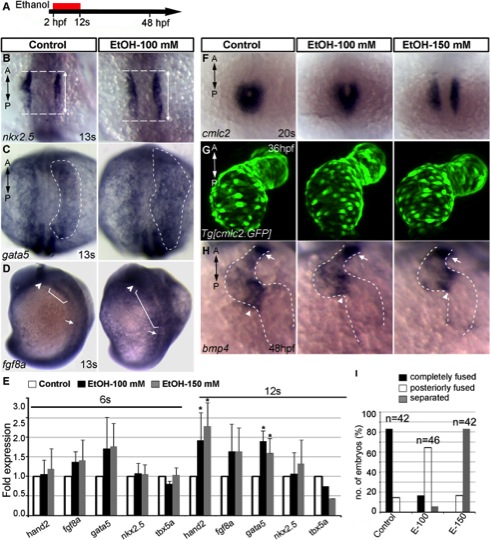Fig. 3 Ethanol exposure during gastrulation through cardiac specification induces defects in cardiac gene expression and myocardial migration. A: Schematic diagram shows the timing of ethanol exposure. B?D: Whole mount ISH at 13s stages showed moderate expansion of expression domains for nkx2.5 (B) (see Fig. 7C for statistical significance), gata5 (C), and fgf8a (D) in the ethanol-treated embryos, as compared to control. E: Transcript levels of genes expressed in differentiating myocardial cells increased after ethanol treatment. Quantitative RT-PCR assays comparing cardiogenic gene expression levels at 6s and 12s stages (average fold change from at least 3 independent experiments), Student′s t-test: *P<0.01. F: ISH detecting cmlc2 at 20s stage showed cardiac fusion delay after ethanol treatment (2 hpf-12s). G: Live images of Tg[cmlc2:GFP] embryos exposed to ethanol (2 hpf-12s) showed normal cardiac looping and normal chamber morphology. H: bmp4 expression examined by ISH. Ethanol-exposed (2 hpf-12s) embryos showed normal bmp4 expression pattern. Arrowheads, AV boundary; arrows, OFT; dotted line, cardiac silhouette. I: Graph illustrates myocardial fusion differences at 20s stage in control and ethanol-treated embryos. Mantel-Haenszel chi-square tests: P<0.0001 for both control versus EtOH-100 and control versus EtOH-150. n, number of embryos; A, anterior; P, posterior.
Image
Figure Caption
Acknowledgments
This image is the copyrighted work of the attributed author or publisher, and
ZFIN has permission only to display this image to its users.
Additional permissions should be obtained from the applicable author or publisher of the image.
Full text @ Dev. Dyn.

